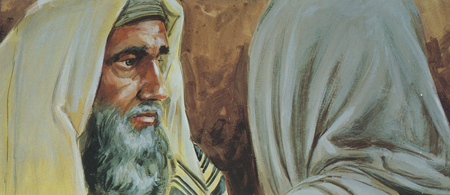The ark has wreaked havoc in Philistia, or so it seems, and the leaders want rid of it. They seek the counsel of the priests and diviners, who suggest returning it with a “guilt offering” so that healing might come to the people. On the one hand, they assume that the trouble that has befallen them is the direct action of Israel’s God. On the other, however, a question remains whether this is in fact the case, or whether they have had a particularly bad run of luck (v. 9). Nonetheless, their counsel assumes that the root of their problems is God.
The guilt offering suggested was five golden mice and five golden tumours—corresponding, probably, to their afflictions, and presumably, to their cause. By sending these tokens with the ark they acknowledged that this plague had come from God, and by sending them out of the country, they also are symbolically sending the plague away. Although it is easy to view the Philistines as deeply superstitious, such a characterisation is less than fair. Indeed, the text itself indicates that the Philistines are aware of what happened to Pharaoh and the Egyptians, and take it as a warning (v. 6).
The priests and diviners do not make it easy on themselves. They insist on a new cart with cattle that have never been yoked. They choose milk cows with calves, but take the calves away from the cows. The cows are left free to go where they will, yet they do not return back to their calves, but go straight toward the land of Israel; the plagues have not been a coincidence.
The people of Beth-shemesh rejoice to see the ark and offer appropriate—and costly—sacrifices. But, and here the story takes an interesting twist, some of the people look into the ark and are struck dead. (One wonders what Calvin would make of those who seek to “peer into the depths of God.” Calvin repudiated such speculative attempts to apprehend the essence of God, and insisted that we content ourselves with that which God has revealed.) Again there is a difficulty in the Hebrew which suggests that perhaps 50,070 people were killed, but the structure of verse nineteen is difficult, and most translations and commentators opt for the more “reasonable” number of seventy. Nevertheless, this cost is too great for the people of Beth-shemesh and they send it away to Kiriath-jearim where it remains for some twenty years.
In chapters four and five we found that God had judged his people and allowed them to be decisively defeated. God has also allowed himself to be “captured,” to be taken into the hands and control of the pagans, to be exiled and cut off from his people. And yet God is not captured, not exiled, not defeated, and not controlled. God remains Lord even in “defeat.” God bears witness to himself where Israel has failed to do so, and so wins the acknowledgement and grudging respect, if not the love, of the Philistines. God has now returned from his exile, returned to his people, but God will not be their captive or their possession either. The people of Beth-shemesh have transgressed the boundary, presumed upon the divine majesty, and failed to consider his holiness. They have not, as the early Barth insisted in his first Romans commentary, “respected the distance.”
It is likely, as Murphy notes (48), that no one really understands the disasters in 1 Samuel 5-6, for the passage lies beyond our historical ability. This does not mean, however, that we can gain no instruction or benefit from it. The ark is the symbol—and sacrament—of the divine presence. Indeed Murphy declares that “it is not possible to understand this carnival of the glory of the Lord in his ark without appreciating sacramental power” (49). The ark is an earthly tangible thing, but simultaneously the divine throne by which God is present with and enthroned amongst his people. Its potency is “a visible symbol” of the glory that it bears (ibid.). As the divine throne it is also sacred, and to be acknowledged, honoured and treated as such. Evans (50) wonders whether Paul might have had a passage like this in mind when he warned against misuse of the Lord’s Supper in 1 Corinthians 11.
Within the overall structure of the narrative, another insight dawns. The ark is now housed at Kiriath-jearim for twenty years—a back-water, out-of-the-way kind of place—side-lined, and marginal to the life of Israel, until David retrieves it and brings it to Jerusalem in 2 Samuel 6. This is a figurative portrayal of the sidelining of God in the national life; the divine kingship is marginal until David is established as king and the ark restored to Jerusalem (see Murphy, 51). If this interpretation is accepted, it provides a lens through which the rest of the book is to be understood, and in particular, the reign of Saul.
One further point of instruction may be possible. It may be appropriate to read this text typologically or allegorically, as pointing to Jesus Christ, who is in his own flesh, the presence and covenant of God with us. He, too, was captured, taken into the hands and control of the pagans, cut off from his people, exiled from God and nation—yet not captured, defeated, exiled or controlled, but victorious. But this text would also warn us that we either have Jesus on his own terms or not at all. He is never our possession, but the holy God who has come to us in mercy, and the merciful God who nevertheless ever remains the holy One who is Lord.
